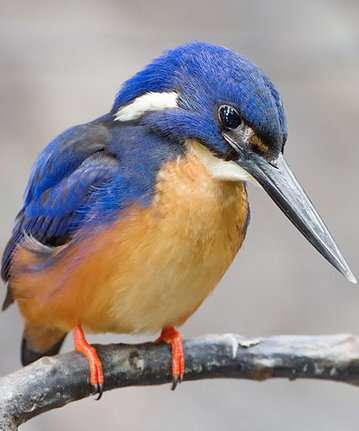Birds 104 Chapter 4
Death from Above! Part 2 - The Kingfisher
Kingfishers are poorly represented in the US, with only one relatively common species, the Belted Kingfisher. Two scarcer southern species, the Green and the Ringed, are found as far north as Texas and the Southwest. Their relative scarcity and compact size cause the Belted Kingfisher to be underestimated as a pond predator - until you see one in action. Well-named indeed, these marvelously well-adapted fishers really are kings of their craft. The foot-tall, stocky bird will typically fly with fast strong wing beats to an exposed perch that gives a clear view down into the pond for target selection. Then, either directly from the perch or hovering high above the pond, the Kingfisher will arrow into the water bill first, submerging completely, rarely surfacing without a goldfish or small koi in its long sharply pointed beak. Easily lifting from the water, they will return to the perch and beat the fish against it to kill it before swallowing it whole head first.
Cavity dwellers, Belted Kingfishers dig a long tunnel sloping upward into the bank along streams or ponds. Both parents care for and feed their young.

By JJ Harrison (jjharrison89@facebook.com) (Own work) [GFDL or CC-BY-3.0], via Wikimedia Commons
So, as fascinating as they are to watch, you will soon tire of their habit of removing all the small fish and tadpoles in your pond. The monofilament trick won’t work with these guys, they’ll just find a way around the lines. About the only way to protect your smaller fish from the Belted Kingfisher is to net the pond. Otherwise, get used to seeing them around until there are no fish under about 4” long left.
Kingfishers are poorly represented in the US, with only one relatively common species, the Belted Kingfisher. Two scarcer southern species, the Green and the Ringed, are found as far north as Texas and the Southwest. Their relative scarcity and compact size cause the Belted Kingfisher to be underestimated as a pond predator - until you see one in action. Well-named indeed, these marvelously well-adapted fishers really are kings of their craft. The foot-tall, stocky bird will typically fly with fast strong wing beats to an exposed perch that gives a clear view down into the pond for target selection. Then, either directly from the perch or hovering high above the pond, the Kingfisher will arrow into the water bill first, submerging completely, rarely surfacing without a goldfish or small koi in its long sharply pointed beak. Easily lifting from the water, they will return to the perch and beat the fish against it to kill it before swallowing it whole head first.
Cavity dwellers, Belted Kingfishers dig a long tunnel sloping upward into the bank along streams or ponds. Both parents care for and feed their young.

By JJ Harrison (jjharrison89@facebook.com) (Own work) [GFDL or CC-BY-3.0], via Wikimedia Commons
So, as fascinating as they are to watch, you will soon tire of their habit of removing all the small fish and tadpoles in your pond. The monofilament trick won’t work with these guys, they’ll just find a way around the lines. About the only way to protect your smaller fish from the Belted Kingfisher is to net the pond. Otherwise, get used to seeing them around until there are no fish under about 4” long left.




